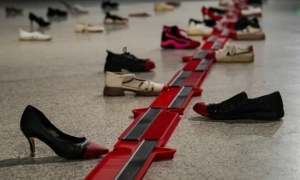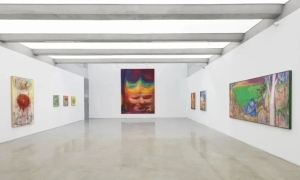帐房先生 不锈钢锻造 80x60x60cm 2007
冯博一
在中国当代艺术这个圈子混久了,或者说在策划展览的过程中与这么多艺术家打交道,他们作品观念的基本脉络和样式大致有些了解。尽管现在各类展览很多,艺术家及作品也很多。但已没有了上世纪90年代的刺激、惊喜与兴奋,抑或这些前赴后继的艺术家原始冲动与激情或多或少地被策略、被日益火爆的艺术市场所左右?面对这些太会做作品,太会做展览的艺术现象,我不知如何回答这个问题,就是感觉有些不大对劲儿。也许是我老了,有些“九斤老太”式的感谓。但当我看到福建漳州的艺术家陈志光的作品时,却追忆出我在90年代的视觉经验。似乎他的艺术现在无法归类,起码不在所谓都市时髦艺术的系统之内。既有那时的破碎激情,又没有太多被当下这个艺术圈内的所濡染的媚俗习气,显得朴素、直接、真挚。这使我想起当年学习美术史时,对民间艺术、民俗风尚价值和意义的看法。作为在大城市兴起的艺术潮流、风格样式,是逐渐地渗透、蔓延、影响到其它各地域的城镇。当大城市的艺术风尚瞬息万变后,地域性的艺术可以作为追索、研究当时城市文化的一个参照系。因为它多少保留了那个时期的审美意识和趣味,又带有地域性文化的融合及掺杂,充满着民间的活力。因此,我在解读陈志光的艺术创作,虽然缺乏现时流行的评价标准,却给我们以另类的审视眼光来看待。
似乎他的艺术现在无法归类,起码不在所谓都市时髦艺术的系统之内。既有那时的破碎激情,又没有太多被当下这个艺术圈内的所濡染的媚俗习气,显得朴素、直接、真挚。这使我想起当年学习美术史时,对民间艺术、民俗风尚价值和意义的看法。作为在大城市兴起的艺术潮流、风格样式,是逐渐地渗透、蔓延、影响到其它各地域的城镇。当大城市的艺术风尚瞬息万变后,地域性的艺术可以作为追索、研究当时城市文化的一个参照系。因为它多少保留了那个时期的审美意识和趣味,又带有地域性文化的融合及掺杂,充满着民间的活力。因此,我在解读陈志光的艺术创作,虽然缺乏现时流行的评价标准,却给我们以另类的审视眼光来看待。
陈志光的艺术有种神秘、诡异的感觉。蚂蚁是陈志光作品里始终青睐的物象。在自然界,蚂蚁的造化是群体的分工劳作,孜孜不倦地觅食、造窝和繁衍,显示出超越个体的自然力量。之所以陈志光不断地利用它们的形象,我揣度有着比附人类的芸芸众生劳作的意味,或许也具有中国传统的“愚公愚山”寓言的象征涵义。比如他将塑造的若干个不锈钢蚂蚁游走、蠕动在曾经辉煌过的工厂、车间的废墟和锈迹斑斑的机器之中,趴伏在废弃的载重卡车和锅炉之上。废墟与残骸,黑暗与扭曲的支离破碎景象充盈在观者的面前,这是他曾经生活在这个环境中生存经验的直接性展开,蕴藏着沉重、留恋、痛惜、伤感的色彩,也是对中国时代变迁过程中产生的冲突、碰撞的一种真实与直接的记录和写照。中国正在失去一个旧秩序,是否能得到了一个新的世界?从这个意义来说,他的这些作品是对即将消失的过去在未来的绝唱与挽歌。再比如,他把蚂蚁拟人化,身穿中国古代盔甲,像是秦始皇墓中的兵马俑,头戴乌纱帽,手拿刀枪剑戟,或端坐在中国古典的太师椅上,或张牙舞爪地在柱础上横空出世,魔幻般乖张的造型,不禁地使人想到我们古典文学经典的《西游记》中的场景,凸现了视觉惊怵的张力。比较有趣的是在材料的选择上,他使用的都是工业文明的“第二手物质”——不锈钢金属锻造或金属喷漆装置而成。这种人工化材料的冰冷属性以及和蚂蚁的自然属性相互混搭覆盖,诱发出历史和虚拟、写实和游戏之间的各种荒谬和困惑。可以看出陈志光的用意是把一群关键性的蚂蚁行为形象,同时赋予了作品内容和形式方面的最大效果,这种效果具有复杂的象征意义,把我们现今社会日益膨胀的物质消费的情景,通过系列蚂蚁的怪异形象符号化和现实化了,甚至挪用和强行并置了两个时代的落差景观,于是视觉的图像从非现实的层面进入到一个现实的层面,以此来表达他对当下现实社会的深刻关注。或许他的这种艺术话语方式的不可思议之处还在于他回到了民间传统和日常生活的趣味,却以他的超现实的想象力,冲击着在都市生活里已经太“雅”的文化人们。恰似将我们这个时代在社会转型过程中的文化处境,以及陈志光作为一位艺术家予以的审视与转化,反映了他对这些社会现实问题的恣肆的想象力和质疑的立场。
The Magic Strangeness
On Chen Zhiguang’s Sculpture
Feng Boyi
I have got some ideas about the basic concepts and patterns with the works of many artists since I have been engaged in the Chinese contemporary art circle and in contact with them when planning exhibitions. Despite the fact that there are so many types of exhibitions, artists and works, there are no longer incentive, surprises and excitement of those of 1990s. Have the basic impulse and passion of these artists been more or less subjected to the strategies or the increasingly heated art market? In the face of the phenomenon that these artists are too good at marketing their works and holding exhibitions, I do not know how to answer this question, but feel that it is not so right, or perhaps I am getting old, just a bit complaining about the present situation and missing the good old days. But when I saw the works of Chen Zhiguang, the artist from Zhangzhou Fujian, it brought me back to the visual experience of the 1990s.
His art now seems unable to be classified, at least not in the so-called urban fashion art system. It possesses both the broken passion of that period, but doesn’t have the phenomenon of flattering favor of the public that can be widely found in the present art circle. It is simple, direct and sincere. This reminds me of the time when I studied art history, my view on the value and significance of the folk arts and folk customs. As the emerging art trend and style pattern in metropolis, these art works are gradually penetrating and spreading out to affect other towns and cities. When the artistic fashion changes rapidly in metropolis, the local arts can serve as a reference system to be referred to when tracing and studying urban culture of that period, because they retained much aesthetic sense and tastes of that period with a regional cultural integration and mixture. They were also filled with folk vitality. Chen Zhiguang’s art can be interpreted and appreciated in an alternative vision, although it lacks present popular evaluation criteria.
Chen Zhiguang’s art would give viewers the feeling of mystery and strangeness. Ants are always the physical image favored in Chen Zhiguang’s art works. In nature, ants are featured with the division of labor, tireless foraging, creating anthills and endless flourishing, showing the natural forces beyond individuals. The reason why Chen Zhiguang constantly uses the image of ants is to compare the toilful mankind to ants’ endless working, or perhaps to the traditional symbolic meaning of the Foolish Old Man, who removed the mountains to show the determination to win victory and the courage to surmount every difficulty. For example, Chen Zhiguang created a number of stainless steel ants moving around, wiggling among the ruins of the workshop and the rusty machinery in the factory that used to be magnificent, or lying prone on the abandoned heavy trucks and boilers. The viewers are presented with a broken picture of ruins and debris, dark and distorted, which is the direct experience of the survival in the environment he once lived. It not only contains colors of heaviness, lingering, regret and sadness, but also reflects the conflicts and collisions during the process of era changing in China.
China is losing an old order. Can she gain a new world? In this sense, his works are the farewell and elegy in the future to those of the past that will soon disappear. For instance, he personalizes the ants, which wear ancient Chinese helmets, just like the terra cottas who wear dark gauze cap, holding knives and swords or sitting up straight in the chair of classical Chinese, or putting on a fierce look around the columns. Their magic and eccentric profiling reminds us of the scenes in our classical literature "Journey to the West", which highlights the visual shocking tension. What is more interesting lies in the choice of materials, which are all the “second hand material” of industrial civilization--stainless steel metal forging or metal painting installation. The coldness of such artificial materials and natural attributes of ants mutual mix and overlap, inducing all kinds of absurd and confusion between history and fiction, realism and games.
It can be seen that Chen Zhiguang’s intention is to adopt the image of a critical army of ants and at the same time endow the content and form of his works with maximum effect, which has complex symbolism, symbolizing the swelling material needs in the modern society through serial strange image of ants. He even shifts and forcefully combines the gap between the two eras, thus the visual image would shift from the unreal dimension into a realistic level to express his deep concern for the current social reality. Perhaps the incredible aspect of his type of artistic words also lies in his return to the folk tradition and interests of daily life. However, with his surrealistic imagination, his art blows at the too "elegant" cultural people in urban life. Just like the cultural situation we would face in the process of social transformation in this era, Chen Zhiguang, as an artist, examines and transfers his art to reflect his unlimited imagination and questioning position toward the social reality.
【编辑:小红】






















